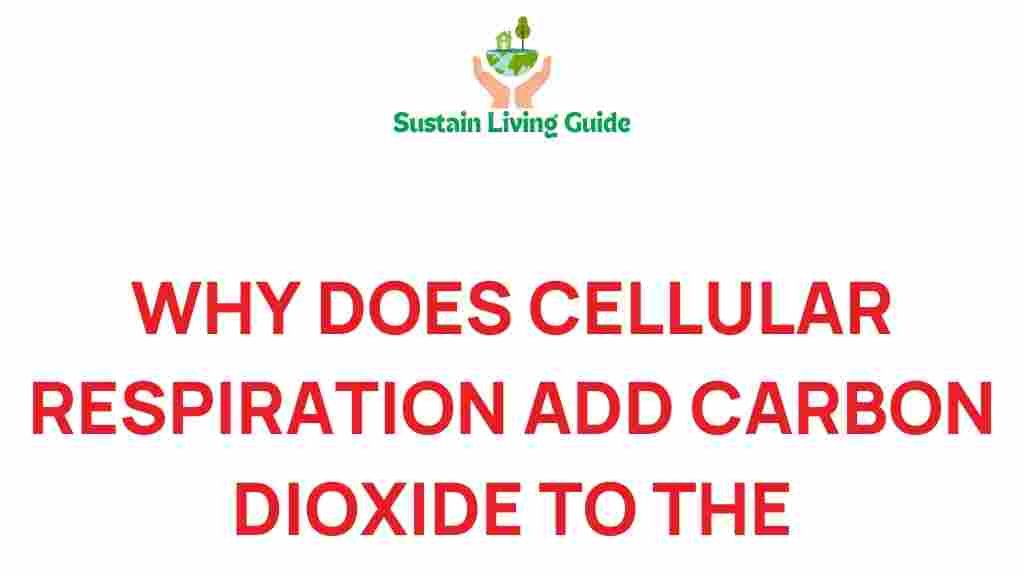Understanding Cellular Respiration
Cellular respiration is a fundamental biological process that occurs in living organisms, enabling them to convert food into energy. This intricate process not only supports life by providing ATP (adenosine triphosphate), the energy currency of cells, but it also plays a crucial role in the cycle of carbon dioxide emissions. In this article, we will unravel the mystery of how cellular respiration contributes to carbon dioxide emissions, exploring the steps involved, its implications for our environment, and practical tips for understanding this process better.
The Basics of Cellular Respiration
Cellular respiration can be broadly categorized into two types: aerobic and anaerobic respiration. Both processes result in the production of energy, but they differ in their requirements for oxygen.
- Aerobic Respiration: This process occurs in the presence of oxygen and is the most efficient way for cells to generate energy. It occurs in three main stages:
- Glycolysis: This first stage breaks down glucose into pyruvate, releasing a small amount of ATP and NADH.
- Krebs Cycle: Also known as the citric acid cycle, this stage takes place in the mitochondria and processes pyruvate to produce more ATP, NADH, and FADH2, while releasing carbon dioxide as a by-product.
- Electron Transport Chain: In this final stage, the high-energy electrons from NADH and FADH2 are transferred through a series of proteins, producing a significant amount of ATP while consuming oxygen and releasing water and carbon dioxide.
Anaerobic Respiration: This process occurs in the absence of oxygen and results in less energy production. It typically results in by-products such as lactic acid or ethanol along with carbon dioxide.
How Cellular Respiration Contributes to Carbon Dioxide Emissions
During aerobic cellular respiration, carbon dioxide is produced as a natural by-product. Here’s a step-by-step breakdown of how this occurs:
1. Glycolysis
Glycolysis occurs in the cytoplasm, where glucose is split into two molecules of pyruvate. While this stage does not produce carbon dioxide directly, it sets the stage for the following reactions that do.
2. The Krebs Cycle
When pyruvate enters the mitochondria, it undergoes a series of reactions that form acetyl-CoA. This molecule enters the Krebs Cycle, where it is further broken down. For each turn of the cycle, two molecules of carbon dioxide are released:
- For each acetyl-CoA that enters the cycle, two carbon atoms are released as carbon dioxide.
- This process is essential for regenerating key molecules that are used in glycolysis and the electron transport chain.
3. The Electron Transport Chain
While the electron transport chain itself does not produce carbon dioxide, it is dependent on the Krebs Cycle, where carbon dioxide is generated. Additionally, the consumption of oxygen in this process facilitates the conversion of energy from electrons into ATP, highlighting the interconnectedness of these stages.
The Environmental Impact of Carbon Dioxide Emissions
Carbon dioxide is a greenhouse gas, and its accumulation in the atmosphere is a significant driver of climate change. The emissions resulting from cellular respiration, particularly in large-scale agricultural and industrial practices, contribute to this problem. Understanding the relationship between cellular respiration and carbon dioxide emissions is vital for developing strategies to mitigate climate change.
Implications of Cellular Respiration in Different Organisms
The role of cellular respiration varies across different organisms. Here’s how it impacts various sectors:
- Plants: Although plants undergo cellular respiration, they also perform photosynthesis, which absorbs carbon dioxide. The balance between these processes is crucial for maintaining atmospheric carbon levels.
- Animals: Animals primarily rely on aerobic respiration, leading to significant carbon dioxide emissions, especially in urbanized areas with high energy consumption.
- Microorganisms: Many microbes contribute to carbon cycling through respiration and fermentation processes, affecting soil health and nutrient availability.
Troubleshooting Common Misunderstandings about Cellular Respiration
Understanding cellular respiration can be complex. Here are some common misconceptions and clarifications:
- Misconception: Cellular respiration only occurs in animals.
- Clarification: All living organisms, including plants and fungi, undergo cellular respiration.
- Misconception: Carbon dioxide is solely a waste product.
- Clarification: While carbon dioxide is a by-product, it plays a role in photosynthesis and the carbon cycle.
Ways to Mitigate Carbon Dioxide Emissions
Reducing carbon dioxide emissions from cellular respiration involves a multi-faceted approach:
- Optimize Energy Use: Implement energy-efficient practices in agriculture and industry.
- Enhance Photosynthesis: Promoting plant growth can help absorb excess carbon dioxide from the atmosphere.
- Adopt Sustainable Practices: Encouraging sustainable agricultural practices can reduce the carbon footprint associated with food production.
Conclusion
Cellular respiration is a vital process for energy production in all living organisms, leading to carbon dioxide emissions that contribute to climate change. By understanding the intricacies of this process and its environmental impact, we can take steps to mitigate carbon emissions and promote sustainability.
For more information on the connections between cellular respiration and the environment, visit this resource. Understanding these biological processes is essential for creating a greener future.
To delve deeper into the science of cellular respiration, check out this article.
This article is in the category Greenhouse and created by SustainLivingGuide Team
